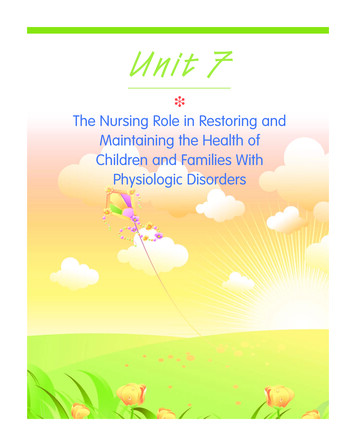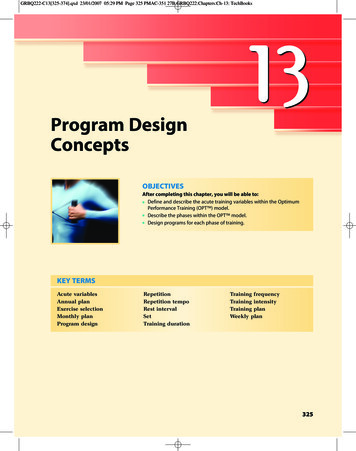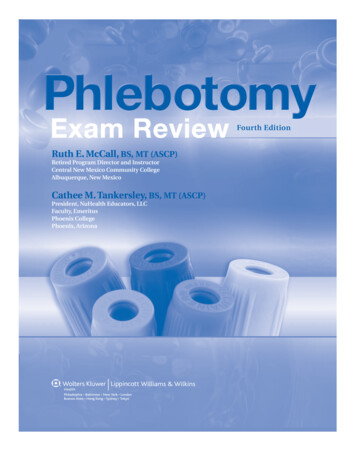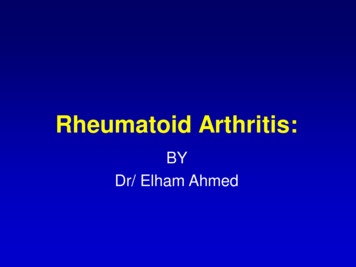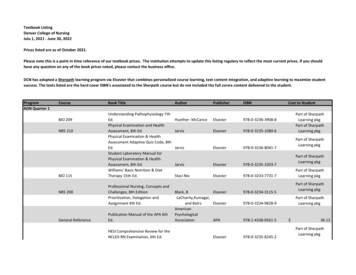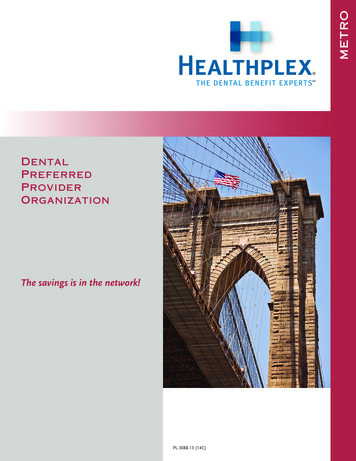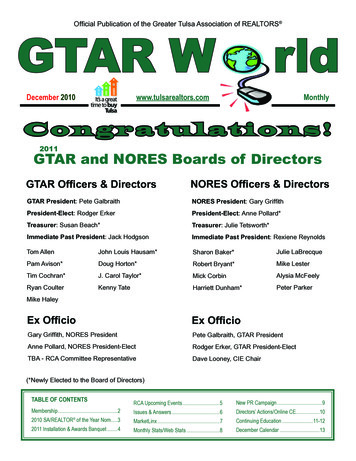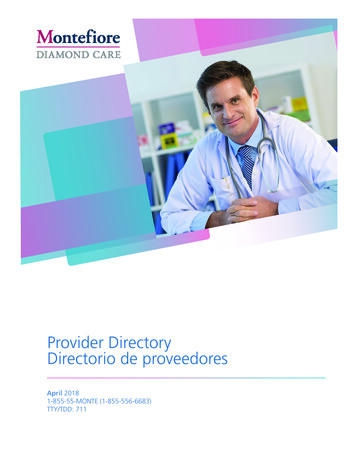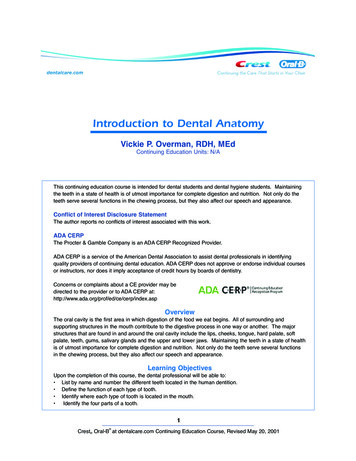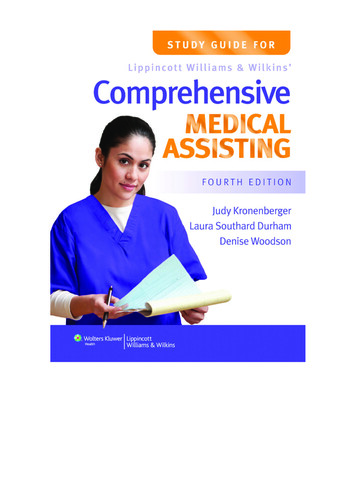
Transcription
STUDY GUIDE FORLippincott Williams & Wilkins’COMPREHENSIVEMedical Assisting
STUDY GUIDE FORLippincott Williams & Wilkins’COMPREHENSIVEMedical AssistingF O U R T HE D I T I O NJudy Kronenberger, RN, CMA, PhDProfessor and Program Director, Medical Assistant TechnologySinclair Community CollegeDayton, OhioLaura Southard Durham, BS, CMAMedical Assisting Technologies Program Coordinator (Retired)Forsyth Technical Community CollegeWinston-Salem, North CarolinaDenise Woodson, MA, MT(ASCP)SCAcademic CoordinatorHealth Sciences and NursingSmarthinking, Inc.Richmond, Virginia
Acquisitions Editor : Kelley SquazzoSenior Product Manager: Amy MillholenDesign Coordinator : Stephen DrudingMarketing Manager : Shauna KelleyCompositor : SPi GlobalPrinter : Data Reproductions CorporationCopyright 2013 Lippincott Williams & Wilkins, a Wolters Kluwer business.351 West Camden StreetTwo Commerce SquareBaltimore, MD 212012001 Market StreetPhiladelphia, PA 19103Printed in the United States of AmericaAll rights reserved. This book is protected by copyright. No part of this book may bereproduced or transmitted in any form or by any means, including as photocopies orscanned-in or other electronic copies, or utilized by any information storage and retrievalsystem without written permission from the copyright owner.The publisher is not responsible (as a matter of product liability, negligence, orotherwise) for any injury resulting from any material contained herein. The publicationcontains information relating to general principles of medical care that should notbe construed as specific instructions for individual patients. Manufacturers’ productinformation and package inserts should be reviewed for current information, includingcontraindications, dosages, and precautions.ISBN: 9781451115727The publishers have made every effort to trace the copyright holders for borrowed material.If they have inadvertently overlooked any, they will be pleased to make the necessaryarrangements at the first opportunity.To purchase additional copies of this book, call our customer service department at(800) 638-3030 or fax orders to (301) 223-2320. International customers should call(301) 223-2300.Visit Lippincott Williams & Wilkins on the Internet: http://www.lww.com. Lippincott Williams &Wilkins customer service representatives are available from 8:30 am to 5:00 pm, EST.131 2 3 4 5 6 7 8 9 10
PrefaceWelcome to the Study Guide for Lippincott Williams &Wilkins’ Comprehensive Medical Assisting, Fourth Edition. In this edition, we have aligned the exercises and activitieswith the most current (2008) Medical Assisting Education ReviewBoard (MAERB) of the American Association of Medical Assistants(AAMA) curriculum standards. Program directors, instructors,and students will know which activities in this Study Guide support comprehension of knowledge from the textbook (cognitivedomain), which support the practice and skills needed to becomea competent entry-level medical assistant (psychomotor domain),and which exercises encourage critical thinking and professionalbehaviors in the medical office (affective domain). This StudyGuide is unique in a number of ways and offers features that arenot found in most Medical Assisting study guides.The Study Guide is divided into sections that coincide with thetextbook: Administrative, Clinical, Laboratory, and Career Strategies. Parts I-IV include exercises that reinforce the knowledge andskills required of all Medical Assistants. Part V includes activitiesto “put it all together” as a potential medical office employee. Allchapters have been updated and revised and we believe the extensive revision of the Clinical Laboratory chapters will be especiallyhelpful.Each chapter includes the following: Learning Outcomes—Learning outcomes are listed at thebeginning of the chapter and are divided into AAMA/CAAHEPcategories (Cognitive, Psychomotor, Affective) and ABHEScompetencies. A Variety of Question Formats—To meet the needs of avariety of learning styles and to reinforce content and knowledge, each chapter of the Study Guide includes multiple choice,matching, short answer, completion, and where applicable,calculation-type questions. These formats will help you retainnew information, reinforce previously learned content, and buildconfidence. Case Studies for Critical Thinking—These scenariosand questions are designed with real-world situations in mindand are intended to promote conversation about possibleresponses, not just one correct answer! These questions willbe valuable to students who confront these types of situationsduring externship and graduates who encounter similar situations after employment. Procedure Skill Sheets—Every procedure in the textbookhas a procedure skill sheet in the Study Guide. These procedures have been updated and revised in this edition and includesteps on interacting with diverse patients, such as those whoare visually or hearing impaired, those who do not speakEnglish or who speak English as a second language (ESL), andpatients who may have developmental challenges. Putting it all Together—Chapter 47 in the textbook allowsstudents in the final stages of their educational program to takea comprehensive examination, and Chapter 47 in the StudyGuide gives students the opportunity to reinforce informationlearned throughout their program. This final Study Guide chapter includes documentation skills practice for a multitude ofsituations and active learning activities to engage students withpreviously learned knowledge.This Study Guide has been developed in response to numerousrequests from students and instructors for a concise, understandable, and interactive resource that covers the skills necessary tobecome a successful Medical Assistant. We hope you find the exercises and tools in this book productive and useful towards yourgoal of becoming the best Medical Assistant possible!v
ContentsPrefacevPART IIIThe Clinical Medical AssistantPART IIntroduction to Medical AssistingUnit One: Understanding theProfession . . . . . . . . . . . . . . . . . . . . . . . . . . . . 31234Medicine and Medical Assisting . . . . . . . . . . . 3Law and Ethics . . . . . . . . . . . . . . . . . . . . . . . 15Communication Skills . . . . . . . . . . . . . . . . . . 31Patient Education . . . . . . . . . . . . . . . . . . . . . 45PART IIThe Administrative Medical AssistantUnit Two: Fundamentals of AdministrativeMedical Assisting . . . . . . . . . . . . . . . . . . . . . . 615The First Contact: Telephone andReception . . . . . . . . . . . . . . . . . . . . . . . . . . . 61678Managing Appointments . . . . . . . . . . . . . . . . 79910Written Communications. . . . . . . . . . . . . . . 103Health Information Managementand Protection. . . . . . . . . . . . . . . . . . . . . . . 117Electronic Applications in theMedical Office . . . . . . . . . . . . . . . . . . . . . . . 133Medical Office Management,Safety, and EmergencyPreparedness . . . . . . . . . . . . . . . . . . . . . . . 147Unit Three: Managing the Finances in thePractice . . . . . . . . . . . . . . . . . . . . . . . . . . . . 1691112131415Credit and Collections. . . . . . . . . . . . . . . . . 169Accounting Responsibilities . . . . . . . . . . . . 185Health Insurance and Reimbursement . . . . 231Diagnostic Coding. . . . . . . . . . . . . . . . . . . . 247Outpatient Procedural Coding . . . . . . . . . . 263Unit Four: Fundamentals of ClinicalMedical Assisting . . . . . . . . . . . . . . . . . . . . . 281161718Nutrition and Wellness . . . . . . . . . . . . . . . . 281Medical Asepsis and Infection Control . . . . 295Medical History and PatientAssessment . . . . . . . . . . . . . . . . . . . . . . . . 30919Anthropometric Measurements andVital Signs . . . . . . . . . . . . . . . . . . . . . . . . . . 32520Assisting with the PhysicalExamination . . . . . . . . . . . . . . . . . . . . . . . . 35921Sterilization and SurgicalInstruments . . . . . . . . . . . . . . . . . . . . . . . . . 373222324Assisting with Minor Office Surgery . . . . . . 3892526Pharmacology . . . . . . . . . . . . . . . . . . . . . . . 421Preparing and AdministeringMedications . . . . . . . . . . . . . . . . . . . . . . . . . 433Diagnostic Imaging . . . . . . . . . . . . . . . . . . . 463Medical Office Emergencies . . . . . . . . . . . . 475Unit Five: Clinical Duties Related to MedicalSpecialties . . . . . . . . . . . . . . . . . . . . . . . . . . 501272829Dermatology . . . . . . . . . . . . . . . . . . . . . . . . 501303132333435363738Pulmonary Medicine . . . . . . . . . . . . . . . . . . 569Orthopedics. . . . . . . . . . . . . . . . . . . . . . . . . 519Ophthalmology andOtolaryngology . . . . . . . . . . . . . . . . . . . . . . 541Cardiology . . . . . . . . . . . . . . . . . . . . . . . . . . 585Gastroenterology . . . . . . . . . . . . . . . . . . . . 601Neurology . . . . . . . . . . . . . . . . . . . . . . . . . . 615Urology . . . . . . . . . . . . . . . . . . . . . . . . . . . . 629Obstetrics and Gynecology. . . . . . . . . . . . . 645Endocrinology . . . . . . . . . . . . . . . . . . . . . . . 665Pediatrics . . . . . . . . . . . . . . . . . . . . . . . . . . 677Geriatrics. . . . . . . . . . . . . . . . . . . . . . . . . . . 695vii
viiiContentsPART IVPART VThe Clinical LaboratoryCareer StrategiesUnit Six: Fundamentals of LaboratoryProcedures . . . . . . . . . . . . . . . . . . . . . . . . . 711Unit Seven: Competing in the JobMarket . . . . . . . . . . . . . . . . . . . . . . . . . . . . . 87939404142434445Introduction to the Clinical Laboratory . . . . 71146Making the Transition:Student to Employee . . . . . . . . . . . . . . . . . 87947Capstone Activities: ApplyingWhat You Have Learned . . . . . . . . . . . . . . 891CLIA Compliance and Laboratory Safety . . 725Phlebotomy . . . . . . . . . . . . . . . . . . . . . . . . . 745Hematology . . . . . . . . . . . . . . . . . . . . . . . . . 773Urinalysis . . . . . . . . . . . . . . . . . . . . . . . . . . 795Microbiology and Immunology . . . . . . . . . . 819Clinical Chemistry . . . . . . . . . . . . . . . . . . . . 859
PA R TIIntroductionto MedicalAssisting
U N I TONEUnderstandingthe ProfessionC H A P T E R1Medicine and Medical AssistingLearningOutcomesCognitive Domain1. Spell and define the key terms2. Summarize a brief history of modernmedicine3. Explain the system of health care in theUnited States4. Discuss the typical medical office5. List medical specialties a medical assistant may encounter6. List settings in which medical assistantsmay be employed7. List the duties of a medical assistant8. Describe the desired characteristics of amedical assistant9. Discuss legal scope of practice for medical assistants10. Compare and contrast physician andmedical assistant roles in terms of standard of care11. Recognize the role of patient advocacy inthe practice of medical assisting12. Identify the role of self boundaries in thehealth care environment13. Differentiate between adaptive and nonadaptive coping mechanisms14. Identify members of the health care team15. Explain the pathways of education formedical assistants16. Discuss the importance of programaccreditation17. Name and describe the two nationallyrecognized accrediting agencies formedical assisting education programs18. Explain the benefits and avenues of certification for the medical assistant19. Discuss licensure and certification as itapplies to health care providers20. List the benefits of membership in a professional organization21. Identify the effect peronal ethics mayhave on professional performance22. Compare personal, professional, andorganizational ethics23. Discuss all levels of governmental legislation and regulation as they apply tomedical assisting practice, including FDAand DEA regulationsPsychomotor Domain1. Perform within scope of practice2. Practice within the standard of care for amedical assistant3. Develop a plan for separation of personaland professional ethics4. Respond to issues of confidentiality5. Document accurately in the patientrecordAffective Domain1. Demonstrate awareness of the consequences of not working within the legalscope of practice2. Apply ethical behaviors, including honesty and integrity in performance ofmedical assisting practice
4PART I Introduction to Medical Assisting3. Examine the impact personal ethics andmorals may have on the individual’spracticeABHES Competencies1. Comprehend the current employmentoutlook for the medical assistant2. Compare and contrast the allied healthprofessions and understand their relationto medical assisting3. Understand medical assistant credentialingrequirements and the process to obtainthe credential. Comprehend theimportance of credentialing4. Have knowledge of the generalresponsibilities of the medical assistant5. Define scope of practice for themedical assistant, and comprehend theconditions for practice within thestate that the medical assistant isemployed6. Demonstrate professionalism by:a. Exhibiting dependability, punctuality,and a positive work ethicb. Exhibiting a positive attitude and asense of responsibilityc. Maintaining confidentiality at all timesd. Being cognizant of ethical boundariese. Exhibiting initiativef. Adapting to changeg. Expressing a responsible attitudeh. Being courteous and diplomatici. Conducting work within scope ofeducation, training, and ability7. Comply with federal, state, and local healthlaws and regulations8. Analyze the effect of hereditary, cultural,and environmental influences
CHAPTER 1 Medicine and Medical AssistingName:COGDate:5Grade:MULTIPLE CHOICE1. Julia is a student in her last year of a medicalassisting program. What must she complete beforegraduating?a. Certificationb. An associate’s degreec. An externshipd. Curriculum2. Who is eligible to take the RMA examination? Circle allthat apply.a. Medical assistants who have been employed asmedical instructors for a minimum of 5 yearsb. Medical assistants who have been employed in theprofession for a minimum of 5 yearsc. Graduates from ABHES-accredited medical assistingprogramsd. Graduates from CAAHEP-accredited medical assisting programs3. Marie and Pierre Curie revolutionized theprinciples of:5. What drives the management practices of the outpatient medical facility?a. The desire to compete with other medicalfacilitiesb. The need to adhere to government rules andregulationsc. The attempt to fit into mainstream medicalopiniond. The effort to retain medical employeese. The focus on hiring specialized health careworkers6. Which of the following tasks is the administrative teamresponsible for in the medical office?a. Physical examinationsb. Financial aspects of the practicec. Laboratory test processingd. Minor office surgerye. Drawing blood7. Which of the following is a clinical duty?a. nursing.a. Scheduling appointmentsb. disease.b. Obtaining medical historiesc. infection.c. Handling telephone callsd. physics.d. Filing insurance formse. radioactivity.e. Implementing ICD-9 and CPT coding for insuranceclaims4. The medical assistant’s role will expand over timebecause of:8. Empathy is the ability to:a. a growing population.a. care deeply for the health and welfare of patients.b. the risk of disease and infection.b. keep your temper in check.c. advances in medicine and technology.c. show all patients good manners.d. a financial boom.d. remain calm in an emergency.e. more effective training programs.e. feel pity for sick patients.
6PART I Introduction to Medical Assisting9. If a patient refers to you as a “nurse,” you should:14. All accredited programs must include a(n):a. call the physician.a. medical terminology course.b. ignore the mistake.b. computer course.c. politely correct him or her.c. externship.d. send him or her home.d. certification examination.e. ask the nurse to come into the room.e. multidisciplinary program.10. A group of specialized people who are broughttogether to meet the needs of the patientis called:15. What is the requirement for admission to the CMA examination?a. Successful completion of 60 CEUsa. multiskilled.b. Successful completion of an externshipb. multifaceted.c. Graduation from high schoolc. multitasked.d. multidisciplinary.d. Graduation from an accredited medical assistingprograme. multitrained.e. Successful completion of a GED program11. A medical assistant falls into the category of:16. An oncologist diagnoses and treats:a. nurse.a. disorders of the musculoskeletal system.b. physician assistant.b. disorders of the ear, nose, and throat.c. medical office manager.c. pregnant women.d. allied health professional.d. the aging population.e. all of the above.e. benign and malignant tumors.12. The discovery of which vaccine opened the door to anemphasis on preventing disease rather than simplytrying to cure preventable illnesses?a. Smallpoxb. Cowpoxc. Puerperal feverd. Typhoide. Influenza13. “Scope of practice” refers to:a. the tasks a person is trained to do.b. the tasks an employer allows an employee toperform.c. limitations placed on employees by law.d. a concept that varies from state to state.e. all of the above.17. A CMA is required to recertify every:a. 1 year.b. 2 years.c. 5 years.d. 10 years.e. 15 years.18. Which organization offers the RMA examination?a. American Medical Technologistsb. American Association of Medical Assistantsc. American Academy of Professional Codersd. American Health Information ManagementAssociatione. American Board of Medical Specialties
CHAPTER 1 Medicine and Medical Assisting19. Which of the following is a benefit of association membership?721. A goal of regenerative medicine is to:a. replace the need for organ donation.a. Time off from workb. slow the healing process.b. Networking opportunitiesc. provide more health care jobs.c. Hotel expensesd. sell organs commercially.d. Free health insurancee. win the Nobel Prize in the medicine category.e. Externship placement22. “Standard of care” refers to:20. Which specialist diagnoses and treats disorders of thestomach and intestines?a. the focus of medicine.b. Gastroenterologistb. generally accepted guidelines and principles thathealth care practitioners follow in the practice ofmedicine.c. Gerontologistc. a physician’s specialty.d. Podiatristd. a concept that only applies to physicians.e. Interniste. a policy that was written by Hippocrates.a. EndocrinologistCOGMATCHINGGrade:Match the following key terms to their definitions.Key Terms23. caduceus24. medical assistant25. outpatient26. specialty27. clinical28. administrative29. laboratory30. multidisciplinary31. inpatient32. externshipDefinitionsa. completed by a CMA every 5 years by either taking the examination again or byacquiring 60 CEUb. describing a medical facility where patients receive care but are not admitted overnightc. a subcategory of medicine that a physician chooses to practice upon graduationfrom medical schoold. referring to a team of specialized professionals who are brought together to meetthe needs of the patiente. regarding a medical facility that treats patients and keeps them overnight, oftenaccompanied by surgery or other proceduref. a medical symbol showing a wand or staff with two serpents coiled around it
8PART I Introduction to Medical Assisting33. accreditation34. certificationg. voluntary process that involves a testing procedure to prove an individual’s baselinecompetency in a particular area35. recertificationh. regarding tasks that involve direct patient carei. an educational course during which the student works in the field gaining hands-onexperiencej. a multiskilled health care professional who performs a variety of tasks in a medicalsettingk. a nongovernmental professional peer review process that provides technical assistance and evaluates educational programs for quality based on pre-established academic and administrative standardsl. regarding tasks that involve scientific testingm. regarding tasks that focus on office proceduresCOGSHORT ANSWERGrade:36. What is the purpose of the Centers for Medicare and Medicaid Services?37. The following are three specialists who may employ medical assistants. Describe what each does.a. allergist:b. internist:c. gynecologist:
CHAPTER 1 Medicine and Medical AssistingCOGIDENTIFICATION9Grade:As a medical assistant, you must be “multiskilled,” or skilled at completing many different tasks. Almost all the tasks youwill complete fall into one of two categories: administrative and clinical. But what’s the difference between administrative andclinical tasks? Read each selection below and determine whether the task requires your clinical or administrative skills, thenplace a C or an A beside the task.38. preparing patients for examinations39. maintaining medical records40. ensuring good public relations41. obtaining medical histories42. preparing and sterilizing instruments43. screening sales representativesAFFSHORT ANSWERGrade:44. What qualities do you possess that would make you a valuable member of your professional organization?45. List the characteristics that you possess that will make you a successful medical assistant.46. List any personal characteristics you believe you could improve.
10PART I Introduction to Medical Assisting47. Describe the personal appearance of a professional medical assistant.48. What are the two accrediting bodies for the medical assisting education arena?49. What is the importance of having adaptive coping mechanisms in place? Give an example of a situation in which suchtools would be helpful.50. How would you answer the question, “Legally, who is responsible for the actions of CMAs or RMAs as they performtheir skills?”51. You are a CMA in a busy Ob/Gyn practice. You have been asked to orient a high school student who was hired to helpup front and in medical records in the afternoons. She wants a career in health care but is unsure if she would behappier in a doctor’s office or a hospital. She is debating between becoming a CMA or a CNA but is confused aboutthe difference. She asks for your help in deciding what profession to choose. How would you explain the difference inthe two careers?
CHAPTER 1 Medicine and Medical Assisting1152. Why is the ability to respect patient confidentiality essential to the role of the medical assistant?53. The medical office in which you work treats a variety of patients, from all ages and backgrounds. Why should youwork with a multidisciplinary health care team? What are the benefits to the patients?WHAT WOULD YOU DO?Grade:54. You are preparing a patient for her examination, but the physician is running behind schedule. The patient is becoming anxious and asks you to perform the examination, instead of the physician. You tell her that you will go checkhow much longer the physician will be. But she responds, “Can’t you just perform the exam? Aren’t you like anurse?” How should you respond?55. The patient who asked you to perform the examination now refuses to wait for the physician. Even though she has aserious heart condition requiring monthly checkups, she leaves without being treated by the physician. You need towrite a note that will be included in her chart and in an incident report. What would you say?
12PART I Introduction to Medical AssistingCOGAFFPSYACTIVE LEARNINGGrade:56. Review the list of specialists who employ medical assistants in textbook Table 1-2. Choose one specialty that interestsyou. Perform research on what kinds of procedures the specialist performs. Then consider what kinds of tasks amedical assistant employed by this specialist might perform. Write a letter to this specialist explaining why you wouldwant to work in this kind of office. Be sure to include specific references to the tasks and procedures that interest youbased on your research.57. Scope of practice for medical assistants can vary from state to state. In some states, CMAs are not allowed to perform invasive procedures, such as injections or phlebotomy. Go to the Web site for your state and research the lawsin your state regarding the medical assistant’s scope of practice. Why is it important to understand your scope ofpractice before beginning work in a new medical office?AFFCASE STUDY FOR CRITICAL THINKING AGrade:You are a CMA in a family practice where many of your friends and neighbors are patients. One of them is being treated forbreast cancer. It seems as though everywhere you go, someone asks about her condition. They are just concerned, and soare you. You really want to give them an update on her treatment, but you know that is prohibited.58. What is your best action? Choose all appropriate actions from the list below.a. Ask the patient if she minds letting you give updates to their mutual friends.b. Tell them that you would be violating a federal law if you discuss her care, but they should call her to find out.c. Tell them what they want to know. After all, they are asking because they care.d. Offer to help your friend/patient join a Web site that will allow her to update her friends.
CHAPTER 1 Medicine and Medical AssistingAFFCASE STUDY FOR CRITICAL THINKING B13Grade:You start your new position as a CMA for a busy pediatric practice. You are unsure of your job responsibilities, but the officemanager expects you to “hit the ground running.” Your first day is busy, and you are asked to handle the phones. Your firstcaller is a mother who is worried about her child’s fever.59. Your best response is:a. Don’t worry. I’m sure she will be fine.b. Let me check the office protocol for children with fever. I will call you back.c. Today is my first day; I don’t know, but I think she will be fine.d. You will need to make an appointment.e. I’ll put you through to the doctor immediately.60. What action could have prevented this uncomfortable situation?a. Having the opportunity to observe the office for a few weeks before startingb. Having read the policy and procedure manual before starting workc. Having more experience in the medical assisting fieldd. Paying better attention in classe. Refusing to answer the phone61. You ask another CMA what you should do, and her response is, “I thought you were a CMA; you should know what todo.” What is your next best action?a. Go immediately to your supervisor for guidance.b. Tell another co-worker what she said and ask what she thinks you should do.c. Start looking for another job.d. Tell her that if the facility had trained you properly, you would have known what to do.e. Tell her that you are doing your best, and you are sure you will get up to speed soon.
14PART I Introduction to Medical AssistingAFFCASE STUDY FOR CRITICAL THINKING CGrade:Mrs. Esposito approaches Jan, a medical assistant, at the front desk. Jan has recently treated Mrs. Esposito’s son, Manuel,for a foot injury. Mrs. Esposito has just arrived in the United States and, with broken English, asks Jan if she may have herson’s medical records to show Manuel’s soccer coach that he will be unable to play for the rest of the season. Jan tries toexplain to Mrs. Esposito that because her son is 18 years old and legally an adult, she must have his permission to release hismedical records. Mrs. Esposito is frustrated and angry. Using Spanish translating software, Jan calmly attempts to explainthat the physician would be happy to write a note for Manuel to give to his soccer coach explaining his injuries. After a greatdeal of time and effort, Mrs. Esposito thanks her for this information and apologizes for becoming angry.62. From the list below, choose the characteristic of a professional medical assistant that Jan exhibited in the above scenario.a. Accuracyb. Proper hygienec. The ability to respect patient confidentialityd. Honesty63. What was the best action for Jan when she learned that Mrs. Esposito did not speak much English?a. Look in the Yellow Pages for a translatorb. Try to find a Spanish translating software onlinec. Enlist the assistance of a fellow employee who speaks fluent Spanishd. Tell Mrs. Esposito to come back when she can bring a translator64. When dealing with an angry person such as Mrs. Esposito, the most important action is to:a. Raise your voice so she will hear youb. Treat her as she is treating youc. Remain calmd. Notify the office manager of a problem65. When responding to a request for the release of medical information, your first action should be to:a. explain the policy to the patientb. check for the patient’s signed authorizationc. ask the physiciand. copy the records
C H A P T E R2Law and EthicsLearningOutcomesCognitive Domain1. Spell and define the key terms2. Discuss all levels of governmentallegislation and regulation as they applyto medical assisting practice, includingthe Food and Drug Administration andthe Drug Enforcement Agency3. Compare criminal and civil law as itapplies to the practicing medical assistant4. Provide an example of tort law as itwould apply to a medical assistant5. List the elements and types of contractual agreements and describe the difference in implied and express contracts6. List four items that must be included in acontract termination or withdrawal letter7. List six items that must be included in aninformed consent form and explain whomay sign consent forms8. List five legally required disclosures thatmust be reported to specified authorities9. Describe the four elements that must beproven in a medical legal suit10. Describe four possible defenses againstlitigation for the medical professional11. Explain the theory of respondeat superior, or law of agency, and how it appliesto the medical assistant12. Outline the laws regarding employmentand safety issues in the medical office13. Identify how the Americans withDisabilties Act applies to the medicalassisting profession14. Differentiate between legal, ethical andmoral issues affecting health care15. Explain how the following impact themedical assistant’s practi
a competent entry-level medical assistant (psychomotor domain), and which exercises encourage critical thinking and professional behaviors in the medical offi ce (affective domain). This Study Guide is unique in a number of ways and offers features that are not found
